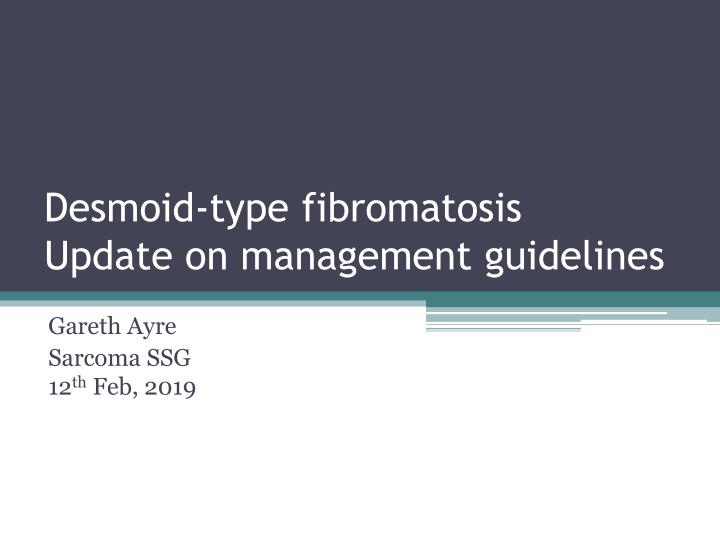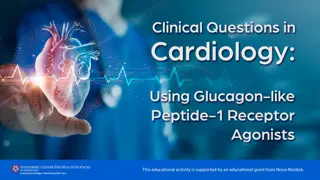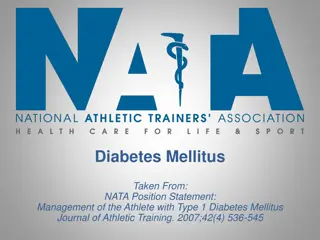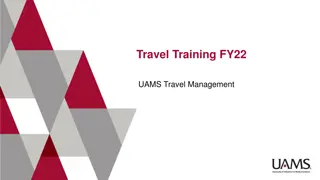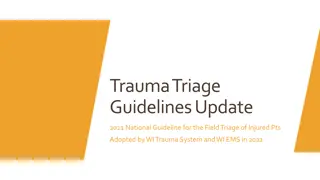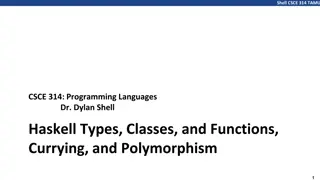Update on Desmoid-Type Fibromatosis Management Guidelines
Desmoid-type fibromatosis is a rare fibroblastic proliferation with varied clinical courses. Treatment is rarely needed upfront, with observation recommended due to potential spontaneous regression. Surgery should be considered based on specific criteria, with a watch-and-wait protocol for monitoring progression before active treatment. Detailed management algorithms are available for guiding therapeutic decisions.
Download Presentation

Please find below an Image/Link to download the presentation.
The content on the website is provided AS IS for your information and personal use only. It may not be sold, licensed, or shared on other websites without obtaining consent from the author.If you encounter any issues during the download, it is possible that the publisher has removed the file from their server.
You are allowed to download the files provided on this website for personal or commercial use, subject to the condition that they are used lawfully. All files are the property of their respective owners.
The content on the website is provided AS IS for your information and personal use only. It may not be sold, licensed, or shared on other websites without obtaining consent from the author.
E N D
Presentation Transcript
Desmoid-type fibromatosis Update on management guidelines Gareth Ayre Sarcoma SSG 12thFeb, 2019
Introduction Desmoid-type fibromatosis (DF) is a rare monoclonal, fibroblastic proliferation characterized by a variable and often unpredictable clinical course. Peak age 30 40 5 10% occur in the context of FAP (Gardner s syndrome) Diagnosed on biopsy Positive nuclear immunostaining for -catenin in 85-90% Confirmed by CTNNB1 activating mutation in equivocal cases -catenin and APC mutations are mutually exclusive MRI
Indications for treatment Upfront treatment is rarely indicated Only of patients progress within 5 years with observation Spontaneous regression seen in 20-30%
Indications for treatment Pain No Pregnancy No (40-50%) progress but usually self-limiting May wish to delay pregnancy Cosmesis Possibly Abdo desmoid causing obstruction or perforation Yes
Should anyone have upfront surgery? Initial observation generally appropriate for all Surgery on progression an option if likely to control disease with minimum morbidity: Age > 25 Tumour < 10cm Abdominal wall site ??Upfront surgery if progression would make surgery significantly more morbid and patient fits the criteria above Aim for microscopically negative margins But function preservation takes priority
E.g. 32 year old 8 cm desmoid Surgical control at 5y: Abdo wall 90% Extremity 57%
Watch and wait protocol Year 1 3 monthly review Years 2 5 6 monthly review MRI at 6m intervals Early imaging if clinical progression If clinically appropriate, wait until 3 scans have shown progression (1-2 years) before starting active treatment
Treatment options Surgery Discussed S + adjuvant RT No benefit if completely excised Reduces recurrence is excision incomplete Especially if surgery for recurrent disease Medical Anti-hormonal treatment NSAIDs Low-dose chemo (e.g. oral vinorelbine) Tyrosine kinase inhibitors Full dose chemo (e.g. Caelyx) RT alone
Medical treatment Hormonal Tamoxifen 20mg bd +/- NSAID (e.g. meloxicam) Radiological response rare (1/2 enlarge) Symptomatic benefit in 32% Reduction in T2 signal intensity correlates with benefit Chemo Failure of hormonal treatment Aggressive growth Critical anatomic site Originally weekly iv chemo for 1-2 years 50% RECIST response, 80% symptomatic response mPFS 6 years Oral vinorelbine also an effective option Full-dose chemo as last resort for abdo / H&N cases TKI Imatinib arrests progression in at 2 years
Others RT Effective 70 80% local control at 10 years Generally reserved for progressive, inoperable, symptomatic patients 2nd cancer risk especially in young Reduced mobility in deep tumours ILP An alternative for progressive extremity tumours where surgery would lead to loss of function Cryo / thermal ablation Only 1 centre has published but excellent outcomes
Abdo wall 1. Hormonal treatment 2. Surgery on progression (or upfront in selected cases)
Intra-abdominal 1. W & W 2. Surgery on progression (not in FAP) 3. Medical therapy if inoperable or recurs Retroperitoneal / Pelvic 1. W & W 2. Medical therapy 3. Different medical treatment / surgery if resectable / RT
Extremities / Limb girdle / Chest wall 1. W & W ( consider early treatment if lesion threatens vessels / nerves) 2. Medical therapy 3. Surgery 4. RT 5. ILP
Patient perspective Diagnosis often delayed Uncertainties regarding diagnosis, treatment, possible recurrence Peak age 35 / female predominance impacts on family planning Psych input / patient support groups may help some
